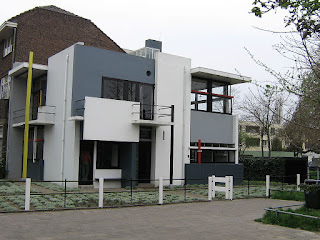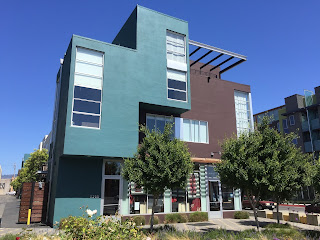Emeryville in the 21st Century
Becomes Utrecht in the 20th Century
Becomes Utrecht in the 20th Century
De Stijl Look-a-Likes Run Amok
Vernacular Architecture Replaced by Historic Simulacrum
Architectural Criticism
 |
| Rietvelt Schroder House Utrecht 1924 Could be Emeryville 2015 (or anywhere else for that matter). |
Emeryville's first 90 years were a period of building, a time when the town rose from small farming tracts of the 19th century to a mostly industrial and commercial city resplendent with an archetypal and vernacular architecture. The second period in Emeryville architectural history, reflecting the town's demographic metamorphosis, is one of destruction of the first period and its replacement.
 |
| Garrit Rietvelt 1888-1964 Since his geest is remaking our town, we ought to know who he is. |
Even the 'slum clearance' and 'blight' language used by Emeryville's City Managers throughout the period of destruction mirrors the earlier time when the rest of America was learning its lessons about the value of retaining architectural legacy. Fifty years after America began to reject the overreach of the infamous urban highway builder and slum buster Robert Moses, Emeryville is still carrying on that terrible top down city planning tradition, steeped as it is and was in connected developers privately benefiting at the public's expense.
 |
| Emeryville's new Parc on Powell Building Where have we seen this before? What's Dutch for Deja Vu? |
It's not that we don't appreciate Emeryville's antecedent, the 1915-1931 De Stijl movement. An offshoot of and a contemporary to the influential Bauhaus movement, the De Stijl brought a distillation of the essential modernist reductionist elements and added a regional flavor to the internationalist aspirations of the Bauhaus practitioners. Like many authentic cultural and artistic movements before and since, it was a transformative architectural and design polity, magisterial and optimistic in its outlook with minimalist integrity seeking infusion with sublime philosophic ontological meaning. One only needs a perusal of the writing's of Piet Mondrian, De Stijl's primary fine art representative, to learn of the aspirational and spiritual nature of this movement.
But it's 2015 not 1915 and Emeryville is not Utrecht. And so, as with any mannerist periods, we're left with a mockery; what we're building here and now has all the authenticity and architectural integrity of Disneyland. Like the Bay Street Mall with its corporate simulated look of a real street with real buildings, these ubiquitous De Stijl knock-offs in Emeryville ultimately serve to alienate. It's not just that they're cheap copies, it's that they bake in alienation, especially over time as these buildings age. We can't see this aging well.
Sadly, the buildings that were torn down to build these fake buildings replacing them had real architectural integrity and were conceived and build as part of a genuine vernacular aesthetic. Emeryville is not alone in this it should be noted. Indeed, fake De Stijl is coast to coast now as cities rush to embrace the anachronistic legitimate architectural manifest of a bygone era.
Emeryville had the bad luck to wipe its land clear of buildings (shall we call it Year Zero?) just as this mannerist style began it's choke hold on architect's imaginations nation-wide, so we're chock-a-block now with this silliness. Let's try for some real buildings how about, instead of these stage sets. At least the real De Stijl and the Bauhaus embodied and championed rights for working class people and economic equality. The new De Stijl is vapid and intoned with architectural arrogance. It's just a slick look as one would expect to find in the pages of Dwell.
 |
| California Street San Francisco Fake De Stijl isn't only in Emeryville |
 |
| Main Street Disneyland In the manner of Beaux-Arts, Queen Anne, Richardsonian Romanesque, Victorian. Built in the 1950's, before the De Stijl fad. |

I like those buildings. I'm not seeing a problem.
ReplyDelete"Vapid," "arrogant," and "slick"? Isn't that just name-calling? The "fakes" pictured above all use color and angles imaginatively, compared to the "original" at the top. Emeryville has its share of buildings that are not eye-friendly, but I wouldn't pick on these in particular.
ReplyDeleteAlways interested in seeing other perspectives. The Beaux-Arts example (mainstreet disneyland) is even more egregious than the De Stijl. Have you ever been inside any of those Disney buildings mentioned? The exterior has no relation to the interior and the facade is a stage set. The Victorian style was one of the most oppressive eras in America from robber barons/gilded age, to the lack of women's rights.
ReplyDeleteSo if you want to play the role of critic, I'd suggest sticking to the local political realm.
too bad buildings with true and historical character are being razed in order to make way for these new cookie cutter edifices. every place is beginning to look like every other place.
ReplyDeleteNot every place. EBI converted the historical and (mostly) Art Deco Berkeley Farms building into a school...
Delete" the 1915-1931 De Stijl movement. An offshoot of and a contemporary to the influential Bauhaus movement"
ReplyDeleteDe Stijl influenced Bauhaus, not how you have it.